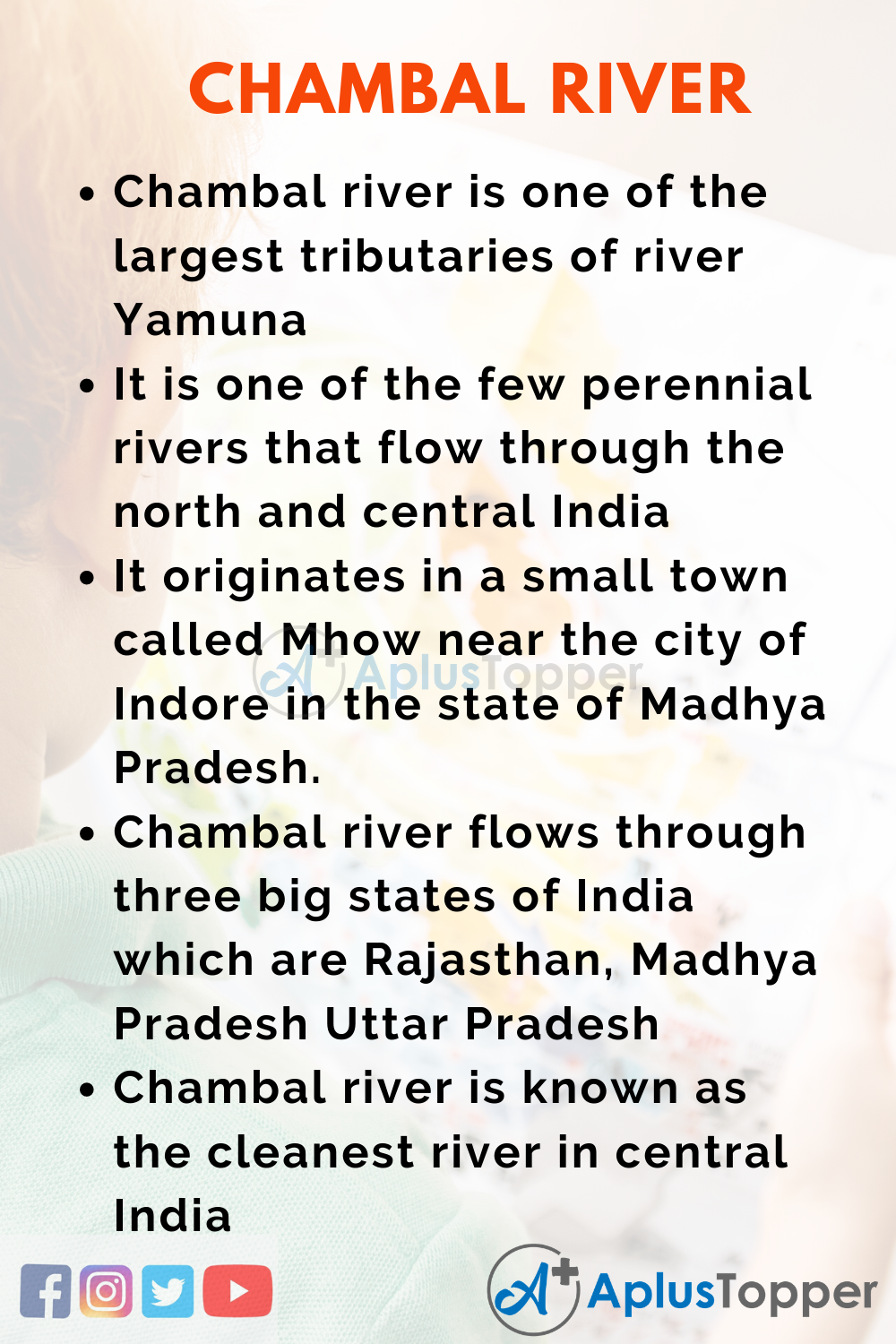10 Lines on Chambal River: The lifeline of the people in the Northern and Central India is the Chambal river. This river flows in three big states in India which are Madhya Pradesh, Uttar Pradesh and Rajasthan. Chambal River is the tributary one of the biggest rivers in India, river Yamuna. Chambal river originates from the Janapav mountain range and it is considered as pure and goddess by some religious groups
In these 10 lines on Chambal river article, we shall be talking about the history of the Chambal river what is the usage of the Chambal river and how has Chambal river helped in developing human civilization across India.
You can read more 10 Lines about articles, events, people, sports, technology many more.
Set 1 – 10 Lines on Chambal River for Kids
Set 1 is helpful for students of Classes 1, 2, 3, 4 and 5.
- Chambal river is one of the largest tributaries of river Yamuna
- It is one of the few perennial rivers that flow through the north and central India
- It originates in a small town called Mhow near the city of Indore in the state of Madhya Pradesh
- Chambal river flows through three big states of India which are Rajasthan, Madhya Pradesh Uttar Pradesh
- Being a river with a length of 960 kilometres and an area of 143219 square kilometres, it is one of the top 10 largest rivers in India
- Chambal river carries silt and nutrients along its journey and hence the region’s surrounding the river is rich in alluvial soil
- There are a large number of human settlements all throughout the nine hundred kilometres of Chambal river and has played a pivotal role in the economic development of those areas
- Chambal river has also helped in improving the eco-tourism sector in certain areas of Uttar Pradesh and Madhya Pradesh
- Chambal river is known as the cleanest river in central India
- The National Chambal Sanctuary is located in the state of Rajasthan.

Set 2 – 10 Lines on Chambal River for School Students
Set 2 is helpful for students of Classes 6, 7 and 8.
- Chambal river, being the biggest tributary of Yamuna, carries along with it the rich alluvial soil and nutrients for good agricultural growth in the states of Uttar Pradesh, Madhya Pradesh and Rajasthan
- The first name of Chambal river is Charmanyavathi
- The river lies in the semi-arid zone of West India which borders the states of Madhya Pradesh, Uttar Pradesh and Rajasthan
- The main dams which are constructed along the 960 kilometres of Chambal river are Gandhi Sagar Dam, Rana Pratap Sagar dam, Jawahar Sagar dam and Kota Barrage
- The different tributaries of the Chambal river are shipra, alnia, mej, banas and prabati
- In the slopes of Chauri peak, Chambal river originates at a height of 884.4 metres
- Irrigation facilities, electricity project and dams are some of the economic development that is happening along the Chambal river
- Chambal river provides a livelihood for lakhs of people in Rajasthan, Madhya Pradesh and Uttar Pradesh in the agricultural sector, tourism sector and fishing
- It is one of the few rivers which are perennial in nature and has to be protected with respect to its aquatic life
- Thousands of rare fishes raised along the 900-kilometre length of Chambal river and pollution has been a great threat to these aquatic animals
Set 3 – 10 Lines on Chambal River for Higher Class Students
Set 3 is helpful for students of Classes 9, 10, 11, 12 and Competitive Exams.
- Chambal river is the second biggest tributary of the river Yamuna which in itself is a tributary of the great Ganges
- The Chambal river houses 4 dams where each of the Dam produces a minimum of 23 million watts of energy
- Other than being a lifeline to the agricultural sector in Rajasthan, Madhya Pradesh and Uttar Pradesh Chambal, this river also has helped in promoting tourism in these three states
- National Chambal Sanctuary was set up in the year 1979 to promote tourism and protection of wildlife along the river
- The Ecotourism spot along the Chambal river is excellent for bird watchers and crocodile watching
- Chambal river faces a grave threat from water pollution and air pollution along the river due to the discharge of toxic waste from the factories
- Chambal river has also been overexploited due to irresponsible and non-judicious agricultural and farming techniques
- Chambal river is also a house for rare tribesmen and bandits in Uttar Pradesh and Madhya Pradesh
- Sand mining, overexploitation, discharge of industrial effluents and destruction of forests landscapes are some of the threats that Chambal river is facing in recent years
- It is said that the quality of the water in the Kota region of Chambal river has come down drastically which is threatening the river ecology around the area

FAQ’s on 10 Lines on Chambal River in English
Question 1.
Where is the Chambal River situated?
Answer:
Chambal river flows through three states in India which are Madhya Pradesh, Rajasthan, and Uttar Pradesh
Question 2.
What is the length of the Chambal river?
Answer:
The complete length of the Chambal river is thousand and twenty-four kilometer
Question 3.
Which is the longest river in India?
Answer:
Indus river, with the length of 2900 kilometers, is the longest river in India
Question 4.
How many dams are situated along the Chambal river?
Answer:
4 dams are situated along the Chambal river for hydroelectric power generation which is Gandhi Sagar Dam, Jawahar Sagar dam and Rana Pratap Sagar Dam and Kota Barrage
